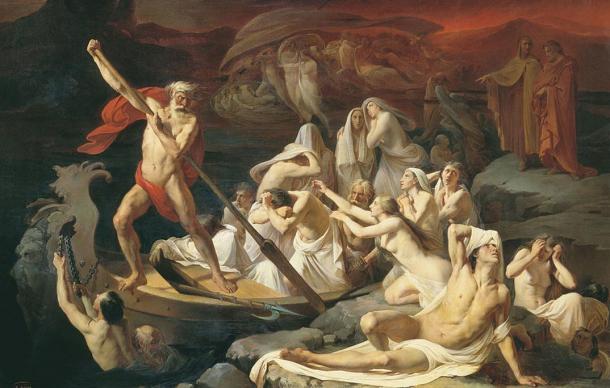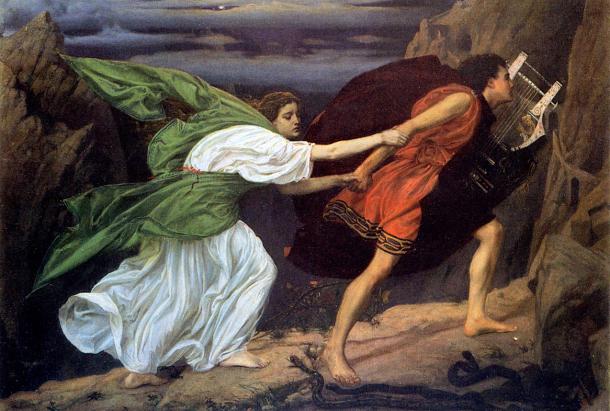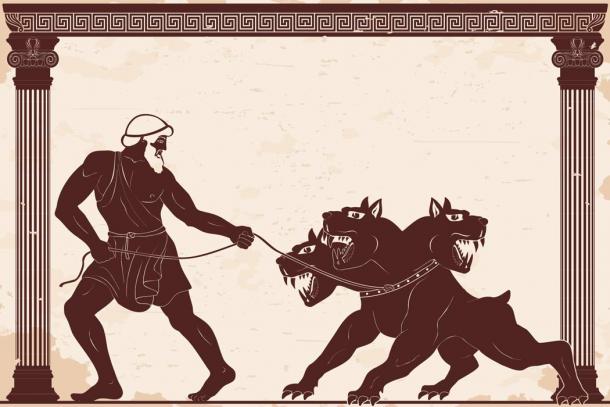In ancient Greek mythology, there exists a three headed dog called Cerberus that guards the entrance to Hades, a misty and gloomy Underworld in which spirits of the dead are permitted to enter but none are allowed to leave. In the ancient world, dogs were often depicted as wild animals that defied domestication, roamed the streets in packs and scavenged on the edge of town. The mythical Cerberus incorporated not only the feared qualities of the ancient canine, but was a strange mixture of several creatures in one and a nightmarish sight to behold.
The Greek Hell Hound Cerberus
The name Cerberus comes from the Greek “Kerberos” meaning “spotted.” To the Greeks, Cerberus was a monstrous three-headed dog, or “hell hound” with a serpent’s tail, a mane of snakes, and a lion’s claws. His three heads were thought to represent the past, the present, and the future while other sources suggest they were symbolic of birth, youth, and old age.
The most potent ability of Cerberus was his look, which was so dreadful that anyone who looked upon him was immediately turned into stone. It was said that Cerberus had razor sharp teeth and a poisonous bite. The poison that drips onto the ground sprung up as a plant that is known as the wolf’s bane.

Cerberus illustration. Hound of Hades. Greek mythology. ( Lunstream /Adobe Stock)
This Hell Hound Had Even More Terrifying Parents
The father of Cerberus was Typhon, the mightiest and deadliest monster in Greek mythology (as well as a god). A huge fire breathing dragon said to have glowing red eyes, a hundred heads, and a hundred wings, the Olympian gods were terrified of him. Everywhere Typhon went, he spread fear and disaster – with his mission being to destroy the world and to put obstacles for Zeus along his path to the Kingdom of Heaven.
Cerberus’ mother, was Echidna, a half-woman, half-snake creature known as the “mother of all monsters”. She had black eyes, the head and torso of a beautiful woman, and the lower body of a serpent. The ancient Greeks believed she dwelt in a cave and lured men in with her body before she ate them raw.
Cerberus and Orpheus
Cerberus’ primary role was the watchdog of the Greek Underworld and faithful servant to the god Hades. His main haunt was along the banks of the river Styx, a river forming the boundary between Earth and the Underworld. He guarded the gates of Hades and prevented the dead from escaping and the living from entering without his master’s permission.
Chained to the entrance gates of Acheron, another river of the Underworld, Cerberus fawned on the dead or new spirits as they entered, but would savagely eat anyone trying to pass back through the gates and return to the land of the living without permission.

Charon, known as the ferryman, taking souls to the river Styx and through to Hades. Artist: Alexander Litovchenko. 1860. ( Public Domain )
Cerberus is featured in several mythological stories as a hell hound and there are even a couple of myths in Greek mythology where a hero gets the better of the beast. The first is when Orpheus, the famed musician of Greek mythology, sneaks into the Underworld by lulling the normally alert and aggressive Cerberus to sleep with his lyre (a type of harp).
The Thracian singer was revered in Greece and happily married to the nymph Eurydice. One day Eurydice was bitten by a snake and died. Orpheus was so grief stricken by his loss that he stopped singing and playing all together. He then decided to risk his own life in a desperate journey to the Underworld to try and rescue Eurydice.
His playing enchanted Charon, the ferryman who carried the souls of the dead across the river Styx and he agreed to take Orpheus across the river, even though he was still living. When he encountered Cerberus, the three headed monster lay down meekly to the strains of Orpheus’s lyre, after which Orpheus was able to gain passage.
Hades and his wife Persephone, granted Eurydice back to Orpheus under one condition: Eurydice must walk behind him as they ascended back to the upper world, and Orpheus was forbidden to look at her. Just before they reached the surface, Orpheus was so overcome with passion that he turned around to look at Orpheus. She was immediately turned into a ghost and sent back to the Underworld forever. Orpheus’ own fate was to be dismembered by Thracian maenads, the female worshipers of Dionysus.

Orpheus leading Eurydice out of the underworld after having played his lyre for Cerberus. Painting by Edward Poytner, 1862. ( Public Domain )
The Hell Hound Versus Hercules
The most famous story of Cerberus involves the half-man, half-god Hercules (Heracles) . As the last of his twelve labors, Eurystheus, the king of Tiryns demanded that Hercules capture and bring Cerberus back alive. Eurystheus was certain that Hercules would fail in this impossible task.
Hercules went to the Underworld, found Hades who told him that if could take Cerberus without the use of weapons, he would be allowed to leave the Underworld with the hell hound. When Hercules found Cerberus on the shore of Acheron, he began wrestling with the huge monster using only his bare hands.
As the world’s strongest man, it took all his power to subdue Cerberus. But the monster soon grew weary, and having run out of breath by the strongman’s chokehold, finally yielded to Hercules. Cerberus is one of the few monsters who ever met Hercules and survived. Unlike other supernatural beasts that crossed his path, Cerberus was returned safely to Hades, where he resumed guarding the gateway to the Underworld.

Hercules abducts Cerberus from Hell. ( migfoto /Adobe Stock)
Cerberus and Other Hell Hounds in Literature
Cerberus is featured in many works of ancient literature, although the depiction surrounding the mythological creature often differs by authors and cultures. Cerberus appears in Dante’s ‘Inferno’, guarding the third circle of Hell rather than the entire Underworld. This is the circle of gluttony, and Cerberus is used to personify uncontrollable appetite.
Cerberus is also featured in many prominent works of Roman literature, most famously in Virgil’s ‘ Aeneid’, and the story of Orpheus in Plato’s ‘Symposium’, and in Homer’s ‘Iliad’, which is the only known reference to one of Heracles’ labors which first appeared in a literary source.
Norse mythology has an equivalent of Cerberus where Hell is guarded by a four-eyed dog named Garm. In Egypt, his incarnation was Anubis, the dog that guarded tombs and conducted the souls to the Underworld.
Some writers, such as the Greek poets Hesiod and Horace, claim Cerberus had as many as 50 or 100 heads and in other descriptions, they are in the shape of a lion, dog, and wolf, respectively. In popular culture, a character based on the beast appears in the Harry Potter film , The Philosopher’s Stone. Called Fluffy, he is lulled to sleep by a flute by Harry in a manner quite similar to the story of Orpheus and Eurydice.

Three-headed dog, Cerberus. ( Archivist/Adobe Stock)





